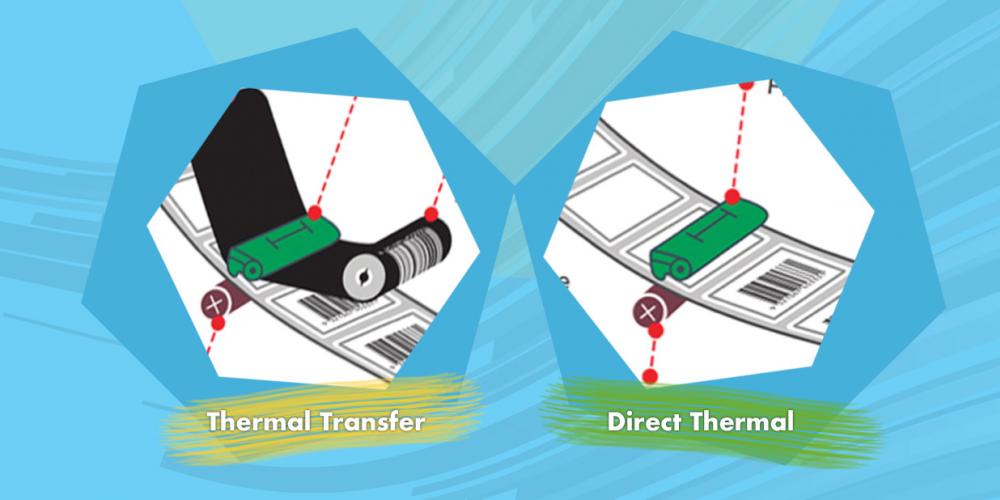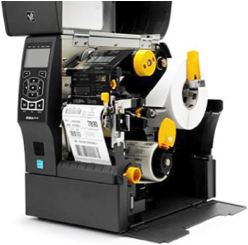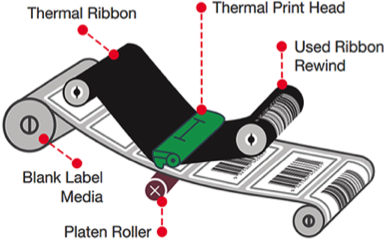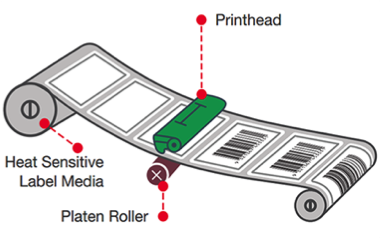Thermal Transfer Printing vs Direct Thermal Printing

 A thermal printer operates by heating a thermal printhead to produce an image. The printhead consists of up to 600 elements per inch. Most thermal printers operate in TT (thermal transfer) or in DT (direct thermal) mode. Thermal printing is popular because of the print quality, rapid print speeds, extreme working environments, quiet operation and substrate versatility.
A thermal printer operates by heating a thermal printhead to produce an image. The printhead consists of up to 600 elements per inch. Most thermal printers operate in TT (thermal transfer) or in DT (direct thermal) mode. Thermal printing is popular because of the print quality, rapid print speeds, extreme working environments, quiet operation and substrate versatility.
Thermal Transfer Printing
Thermal transfer printing is a process that requires thermal transfer ribbons, software and a substrate (i.e., label or tag stock). As the ribbon passes between the printhead and the substrate, the printhead is heated to melt the wax, wax-resin, or resin-based ink off of the polyester coating to transfer the image onto the substrate.
Direct Thermal Printing
Direct thermal printing also uses a print head to generate images but instead of using ribbons to transfer ink, it creates an image directly on the label or tag. Direct thermal printing requires the print head elements be in direct contact with the label material as it is pulled across the print head. This print technology uses chemically treated, heat-sensitive media that turns black when it passes under a heated print head.
Thermal Transfer
Advantages |
Disadvantages |
| Excellent durability | Media/Ribbon loading process is not always “user friendly” |
| High bar code integrity/quality-achieves highest scan rates | Multiple SKU’s to purchase and store |
| Prints extremely small images/bar codes | |
| Good achievability | |
| Up to 16 ips print speed | |
| Longer printhead life due to ribbon back coating | |
| 4 color printers available | |
| Lower cost materials | |
| Variety of ribbon formulations for diverse applications |
Direct Thermal
Advantages |
Disadvantages |
| Single consumable requirement | Limited media options |
| High speed capability | Limited resistance to chemicals and light |
| Extremely portable | Limited resistance to heat and steam |
| New Products - High Speed 10”/Sec., High Heat Resistance & UV Stable | Limited resistance to oils and plasticizers |
| Doesn’t smudge | Reduced printhead life |
| HIPPA compliant – no spent ribbon with patient information | BPA/BPS/leuco dye based |
DT vs TT – Which is Less Expensive…You Might Be Surprised!
| Direct Thermal | Thermal Transfer | Comments | |
| Label Cost | $145,544 | $114,760 | 11.3MM labels |
| Printhead 38% life | $40,950 (91 heads) | $ 15,750 (35 heads) | 69.2mm linear inches |
| Ribbon cost Premium | $0 | $27,800 | 3910 ribbons/yr. |
| Option: GP Wax | $18,064 | ||
| Total Cost 38% life | $186,494 | $ 158,310/$148,574 | Annual Media Spend |
| Annual Savings | $ 28,184/$37,920 | 15%/20% GP vs. Premium |
**According to article published by SATO America, direct thermal printheads provide an expected lifetime of 25-50% of a thermal transfer printhead. This analysis assumes 38%, and average life of 2,000,000 linear inches of per printhead in TT mode.
Assumptions:
- 11.3 MM 4 X 6 shipping labels. 1000 labels/roll.
- Ribbon usage = 3910 ribbons @ 1476’ length.
By switching to IMP’s thermal transfer ribbon, our customer was able to save between 15-20% on their annual ribbon/label spend, depending on which ribbon (general purpose or premium) they selected.
Why Thermal Transfer Printing?
- High Volume Printing Requirements. Thermal transfer printers are designed to complete a full label-printing job in one run.
- Reliability. Thermal transfer printers have one moving part – the paper feed roller.
- Printers are very reliable and are designed to operate in harsh conditions, including both warehousing and manufacturing environments.
- Bar Code Legibility. Thermal transfer printers create bar codes with good scan quality Read rates (98%-100%)
- Durable Print Images. Thermal transfer ribbons have the capability of printing images that can resist extreme temperatures. In addition, thermal transfer ribbons allow for varying degrees of smear, scratch and solvent resistance.
- On-demand Printing Capability. Thermal transfer printing gives the user printing flexibility. Users can print on demand and don't have to pay the extra costs associated with working with an outside supplier to create pre-printed labels.
- Supply Chain Stability. Over the past several years there have been several price increases on direct thermal labels due to a global shortage in a key raw material component, leuco dye. In addition, many direct thermal papers contain Bisphenol A (BPA) which has been shown to cause adverse health effects with exposure. Thermal transfer labels do not contain these chemicals and have become more competitively priced due to increased global production capacity. Lastly, lower cost wax thermal transfer ribbons have helped drive down the overall cost of thermal transfer printing.
Remember, every thermal transfer label sale NEEDS a thermal transfer ribbon! Reach out to us or contact your IMP representative today for pricing, free ribbon samples, or just to strategize on ways we can help you expand your ribbon and label sales.



